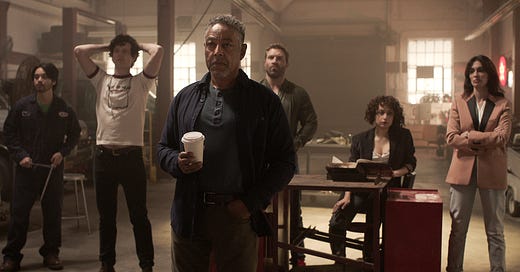TV Review: "Kaleidoscope"
Some thoughts on Netflix's choose-your-own-adventure heist series, and what that means for how we watch television.
Kaleidoscope (Created by Eric Garcia)
In the age of streaming services, “television” often feels like an empty word. Gone are the days of network TV and three-channel stability; long live the era of interactive television specials, multi-part movies, billion-dollar TV shows. The boundary between television, film, and interactivity feels more porous than ever—one could be forgiven for asking what television even is any more. Yet a few commonalities have persisted through it all. By and large, television remains an episodic medium: seasons, episodes, and scenes still form the backbone of TV narrative. When we talk about television, we discuss great episodes, argue over the best season, remember our favorite scenes. However, big, small, or interactive our TV screens may become, we can still count on the consistency of episodic narrative.
With Kaleidoscope, an experimental, choose-your-own-adventure heist series, Netflix attempts to destroy one of the last bastions of the television rulebook: the very order in which we watch these episodes. Creator and showrunner Eric Garcia has designed the show so that viewers can cosnume the show at any sequence that they please, meaning you could start with an episode set twenty-five years before the critical event or one set six months after it. The only rule that Garcia has implemented (one that operates as more of a suggestion) is that you finish the season with “White”—the episode that shows the robbery of a $7 billion vault by a team of criminal professionals.
The idea is an interesting one. If you start with “Red,” for instance, then you get a Reservoir Dogs-style thriller set a few hours after the robbery in which betrayals and mistrust run rampant. Start with “Green” or “Violet” and you go years into the past, looking into different characters’ motivations and backstories. With “Yellow,” “Orange,” or “Blue,” you get a look into the months, weeks, and days leading up to the heist. With the possible exceptions of “Pink” and “Orange,” which build on too much prior knowledge, each and every episode could function as an interesting opener. Which is no small feat, considering how basically contrived it is to watch a show any number of 5,040 different ways (40,320 if you add “White” to the mix).
So, if each episode of the show works as a first, what about as a second? Not quite. In my viewing of the show, I started with “Green,” set seven years before the heist, during protagonist Ray Vernon’s (Giancarlo Esposito) final days in prison. I finished the episode buzzing with excitement, wondering just how and why Ray would plot the upcoming robbery—excitement that came to a swift and immediate end when I decided to watch “Violet,” a random choice that sent me twenty-five years into Ray’s past. Where is the heist? Why should I care about the backstory to a character I had hardly met? All the narrative momentum from “Green” disappeared in one swift motion, and made the show seem like a disjointed mess.
But the beautiful thing about the streaming era is selectiveness and control. Ten minutes into “Violet,” I found myself unhappy and confused, and decided to shift to a different second episode, this time “Yellow,” which was a far better follow-up to “Green.” You could here accuse Garcia of failing to make a 100% comprehensive TV series, but I think this would be missing the point. Kaleidoscope’s freeform approach means that mistakes are OK—no one means of watching the show is The Right One. And that’s awesome! Half of Kaleidoscope’s viewing pleasure comes from realizing that this or that episode could have served as somebody else’s first, that this or that revelation might have felt different in a different order.
Kaleidoscope is still a TV show, however, which means it needs to be entertaining—which it most definitely is. Esposito is predictably great as Ray, mastermind of a plot to steal $7 billion in bearer bonds from the vaults of security magnate Roger Salas, played by a delightfully despicable Rufus Sewel. The decades-spanning narrative involves everything from family betrayals to billionaire bankers to Jai Courtney screaming “Babe!” in his gruff Aussie accent. Speaking of Jai Courtney, he is but one member of an excellent ensemble cast that includes Paz Vega, Rosaline Elbay, Tati Gabrielle, and Peter Mark Kendall, each of whom round out their punky criminal characters with charisma and flair. Dominic Lewis’ funk-synth score is another high point.
The show does have its weaknesses. Many of the action sequences are uninspired and poorly executed, and serve as reminders that our precious Mr. Esposito is now definitely 64 years old. Worse, a good chunk of the show’s dialogue is cringe-worthy nonsense that shows you just how much Garcia is peddling in Tarantino pastiche. Yet I find it hard to blame him. At its best, Kaleidoscope gives you a feeling akin to watching Pulp Fiction for the first time, when you realize how this story overlaps with that one, how certain betrayals intersect with others.
Television is a medium that requires balance. Especially in the streaming service era, when entire seasons are dropped on us as a pigeon might shit on one’s head, television has to engage and entertain at the level of the scene, the episode, and the season all at once. Kaleidoscope isn’t perfect, yet Garcia’s democratization of episode order has resulted in a show that makes you excited about the possibilities of television itself. If the B+ success of this show is anything to go by, we can certainly hope that future showrunners might take this concept even further.



